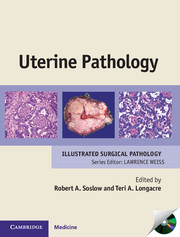Book contents
- Frontmatter
- Contents
- List of contributors
- Preface
- Acknowledgments
- 1 Cytology of the uterine cervix and corpus
- 2 Cervix: squamous cell carcinoma and precursors
- 3 Cervix: adenocarcinoma and precursors, including variants
- 4 Miscellaneous cervical abnormalities
- 5 Non-neoplastic endometrium
- 6 Endometrial carcinoma precursors: hyperplasia and endometrial intraepithelial neoplasia
- 7 Endometrioid adenocarcinoma
- 8 Serous adenocarcinoma
- 9 Clear cell adenocarcinoma and other uterine corpus carcinomas, including unusual variants
- 10 Carcinosarcoma
- 11 Adenofibroma and adenosarcoma
- 12 Uterine smooth muscle tumors
- 13 Endometrial stromal tumors
- 14 Other uterine mesenchymal tumors
- 15 Miscellaneous primary uterine tumors
- 16 Uterine metastases: cervix and corpus
- 17 Gestational trophoblastic disease
- 18 Other pregnancy-related abnormalities
- 19 Lynch syndrome (hereditary non-polyposis colorectal cancer syndrome)
- 20 Cytology of peritoneum and abdominal washings
- Index
- References
8 - Serous adenocarcinoma
Published online by Cambridge University Press: 05 July 2013
- Frontmatter
- Contents
- List of contributors
- Preface
- Acknowledgments
- 1 Cytology of the uterine cervix and corpus
- 2 Cervix: squamous cell carcinoma and precursors
- 3 Cervix: adenocarcinoma and precursors, including variants
- 4 Miscellaneous cervical abnormalities
- 5 Non-neoplastic endometrium
- 6 Endometrial carcinoma precursors: hyperplasia and endometrial intraepithelial neoplasia
- 7 Endometrioid adenocarcinoma
- 8 Serous adenocarcinoma
- 9 Clear cell adenocarcinoma and other uterine corpus carcinomas, including unusual variants
- 10 Carcinosarcoma
- 11 Adenofibroma and adenosarcoma
- 12 Uterine smooth muscle tumors
- 13 Endometrial stromal tumors
- 14 Other uterine mesenchymal tumors
- 15 Miscellaneous primary uterine tumors
- 16 Uterine metastases: cervix and corpus
- 17 Gestational trophoblastic disease
- 18 Other pregnancy-related abnormalities
- 19 Lynch syndrome (hereditary non-polyposis colorectal cancer syndrome)
- 20 Cytology of peritoneum and abdominal washings
- Index
- References
Summary
INTRODUCTION
Uterine serous carcinomas, representing approximately 15% of endometrial carcinomas, are known for being clinically aggressive tumors that disproportionately affect older women. In contrast to the more common endometrioid adenocarcinoma, serous adenocarcinoma is considered to be a type II endometrial cancer according to the Bokhman classification. Type II carcinomas are estrogen independent, typically unassociated with a background of endometrial hyperplasia, and, almost by definition, high grade. Serous carcinoma is unusual in that it is frequently associated with clinically occult extrauterine metastasis, despite the absence of significant uterine enlargement and/or significant tumor volume in the uterus. Reproducible and accurate diagnosis of serous carcinoma is important, as the surgical treatment differs from that of the usual endometrioid adenocarcinoma. Fortunately, in most cases these tumors are easily recognized on an adequate endometrial sampling, but, in some cases, the distinction between serous carcinoma and endometrioid carcinoma can be problematic. Diagnostic strategies that incorporate traditional morphology, immunophenotype, genotype, and patterns of disease dissemination may be helpful, but there are some cases that defy classification; these cases should be reported as high-grade carcinomas with a note that discusses the differential diagnostic problem(s).
CLINICAL CHARACTERISTICS
Uterine serous carcinomas typically occur in the setting of endometrial atrophy, and often involve or arise from atrophic endometrial polyps. In most cases, factors known to predispose for serous carcinogenesis are not evident, but many serous carcinomas occur in patients with a history of breast cancer, including those treated with tamoxifen, and in patients who received previous pelvic radiation therapy for rectal or cervical carcinoma.
- Type
- Chapter
- Information
- Uterine Pathology , pp. 161 - 173Publisher: Cambridge University PressPrint publication year: 2012



